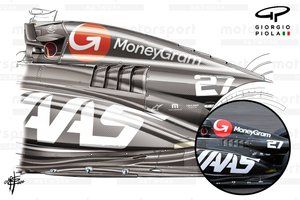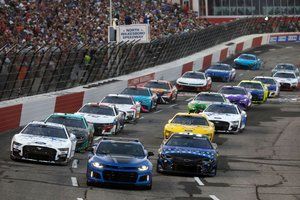Technical analysis: McLaren's F1 steering wheel
Matt Somerfield takes a close look at McLaren's F1 steering wheel and all its functions, more and more complex as electronics continue to evolve in the sport.

Photo by: Honda Racing
Whilst browsing through Twitter on Monday, I noted that Honda had tweeted several pictures of McLaren's steering wheel and pointed out the various functions available to the driver.
While the tweet suggested it was a current wheel, it is not. It is, in fact, the wheel used aboard last year's car, the MP4-30.
However, that doesn't mean we can't discern some information from it, especially as this year's design is very similar.
The steering wheel used on the MP4-31 was first tested during 2015 as operationally it is extremely similar to last season's. In fact, the largest change is a reduction in height at the loss of the blank space below the rotaries.
Now whilst this blank space may seem like a waste, there were undoubtedly components packaged within that have been moved or condensed, in order to reduce the wheel's height.
McLaren has been using a half moon-shaped steering wheel for a number of years but as the rules changed and the complexity of the power units increased, the wheel became a little more bloated.
In part this was due to the PCU8-D LCD screen, which McLaren Technologies introduced to coincide with the 2014 rule changes, affording the driver a better understanding of the car's operational functions in a larger format.
The LCD screen can supply up to 100 pages of tailored information to the driver, which can make looking through this vast array of information difficult.
The driver can scroll through these pages of information using the +/- buttons at the bottom of the wheel. These can be used in combination with the bottom right rotary to jump through multiple screens.
The central rotary is a preset, giving the driver baseline settings to work from based on the tyre selection. You'll note that after a pitstop, be it for a compound change or from dry to wet weather tyres, they'll change the rotary to suit the tyres in use.
Bear in mind that this is not only to do with performance but also because the wet weather tyres have a different circumference. The puncture setting is not only a way of the driver communicating back to the garage to let them know, it is also a recovery map, pre-programmed to limit the power unit whilst driving back to the pitlane.
The left hand rotary is a multi-function switch and can be used in conjunction with the two + buttons at the top of the wheel to make changes to various settings.
In the top corners of the wheel we find two more rotary switches, which have changed orientation in the 2016 redesign. The top left rotary deals with ERS, each number corresponding to the increment of recovery undertaken by the MGU-K.
This has an effect on the car's balance under braking, depending on the amount of energy being recovered. The driver may choose to change this setting for corners of different severity, as the MGU-K will begin to recover energy when lifting out of the throttle. Of course, this then has a cascading effect on how much energy is available for deployment further down the lap.
The right-hand upper rotary deals with brake balance, with the driver able to finely tune how much front-rear bias is deployed by the brakes. Of course, with a brake-by-wire system being employed since 2014, this setting is affected by ERS too, with the system having to check the recovery level of the MGU-K before splitting the front-rear bias.
Below this are another two rotaries. The red one mounted on with the left side is responsible for the various settings that control the hydraulics system, whilst the right-hand green rotary is responsible for the engine map currently being deployed.
These are presets that can be finetuned but offer the driver a quick reference baseline based on the current track conditions. For instance, if they're behind a safety car, they want to use as little fuel and energy as possible, for better use later in the race, whereas during a wheel-to-wheel battle they'll want everything the car has to throw at it.
The mid-wheel rotaries are used to make changes to the differential, which can have a significant impact on how the car behaves during cornering.
These can be used to dial out understeer and oversteer and will often be used during a stint, having an effect on how the car behaves inline with tyre wear and the reduction in car weight as the fuel burns off.
The buttons placed either side of the wheel are single use but offer important functions to the driver nonetheless.
• The white toggle in the upper left corner is for radio communication and could be considered even more important than ever since the rules have changed in regard to radio chatter for 2016. This allows the driver to communicate with the pit wall and discuss any situations that may occur whilst out on track.
• The 'N' button signifies neutral but is also used to then select reverse.
• 'OT' signifies overtake, used as a short-term method of turning all power settings up to their maximum and can used by the driver for both attack or defence. However, use of this can then cause complications further into the lap/session, with the fuel and energy usage affected.
• 'X' is for a quick response to the pitwall to confirm a request via the radio/pitboard. It can also be used to place a marker on the telemetry trace. This is used when the driver notes something affecting the behavior of the car but doesn't have time to relay the information in real time via the radio. This places a mark in telemetry so that the driver and engineers can discuss it afterwards.
• The blue toggle serves multiple functions in regards to the launch mapping.
• PLS is the pitlane speed limiter.
• DRS deploys the rear wing flap during the DRS activation zone during qualifying or when one second behind another driver at the detection point during the race.
• 'D' is for drink - hydration, after all, is a key aspect of driver performance, especially at some of the hotter races on the calendar.
The reduction in the wheel's height has led to some changes at the rear too, with the paddles requiring different spacing. The upper paddles remain closely aligned, whilst the clutch paddles have been moved into close proximity too.
Further changes may be required by the team as it reacts to the regulation changes that permit the use of only one paddle during the start procedure, something Ferrari has already done [below].
Be part of Motorsport community
Join the conversationShare Or Save This Story
Subscribe and access Motorsport.com with your ad-blocker.
From Formula 1 to MotoGP we report straight from the paddock because we love our sport, just like you. In order to keep delivering our expert journalism, our website uses advertising. Still, we want to give you the opportunity to enjoy an ad-free and tracker-free website and to continue using your adblocker.






















Top Comments